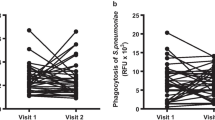Abstract
Soluble triggering receptor expressed on myeloid cells (s-TREM-1) is upregulated on the surface of inflammatory cells in the presence of bacterial infections, apparently excluding those due to Mycobacterium tuberculosis. Therefore, sputum concentrations of s-TREM-1 may be of value in distinguishing bacterial pneumonia from pulmonary tuberculosis (PTB) in patients with respiratory infections. The current pilot study was designed to evaluate whether s-TREM-1 concentrations measured in the sputum of patients with suspected community-acquired pneumonia (CAP) allowed differentiation of those patients with PTB from other causes of pneumonia and to correlate s-TREM-1 with CURB-65, a marker of disease severity. Soluble s-TREM-1 concentrations were measured in sputum samples from patients admitted to a tertiary hospital with CAP or PTB by means of an ELISA procedure. Soluble-TREM-1 was readily detectable and quantifiable in sputum samples from patients with both CAP and PTB, with concentrations of 234 ± 47 and 178 ± 36 pg/ml respectively, but did not differ significantly between the two groups. However, patients with PTB had significantly lower leukocyte counts, 9 ± 1.3 vs 15 ± 1.4 × 109/l compared with those without PTB. Interestingly, sputum s-TREM-1 concentrations correlated significantly with the CURB-65 pneumonia severity score calculated at the time of admission. Soluble-TREM-1 expression is upregulated in patients with both CAP and PTB, but does not differentiate between these two conditions. Sputum concentrations of s-TREM-1 may predict the severity of disease in patients with CAP.

Similar content being viewed by others

References
Bouchon A, Dietrich J, Colonna M (2000) Cutting edge: inflammatory responses can be triggered by TREM-1, a novel receptor expressed on neutrophils and monocytes. J Immunol 164(10):4991–4995
Lourens NA, Bösenberg LH, Tintinger GR et al (2008) Soluble triggering receptor expressed on myeloid cells 1 in patients with suspected meningitis, peritonitis, or pleuritis. Infect Dis Clin Pract 16(3):157–162
Huh JW, Lim C-M, Koh Y et al (2008) Diagnostic utility of the soluble triggering receptor expressed on myeloid cells-1 in bronchoalveolar lavage fluid from patients with bilateral lung infiltrates. Crit Care 12(1):R6
Colonna M, Fachetti F (2003) TREM-1 (Triggering receptor expressed on myeloid cells): a new player in acute inflammatory responses. J Infect Dis 187 [Suppl 2]:S397–S401
Liu C-L, Hsieh W-Y, Wu C-L et al (2007) Triggering receptor expressed on myeloid cells-1 in pleural effusions: a marker of inflammatory disease. Respir Med 101(5):903–909
Areno JP, San Pedro GS, Campbell GD (1996) Diagnosis and prognosis in community-acquired pneumonia: when and where should the patient be treated? Semin Respir Crit Care Med 17(3):231–236
Schluger NW, Rom WN (1994) Current approaches to the diagnosis of active pulmonary tuberculosis. Am J Respir Crit Care Med 149(1):264–267
Bartlett RC (1974) A plea for clinical relevance in microbiology. Am J Clin Pathol 61(6):867–872
Pizzichini E, Pizzichini MMM, Efthimidadis A et al (1996) Measurement of inflammatory indices in induced sputum: effects of selection of sputum to minimize salivary contamination. Eur Respir J 9(6):1174–1180
Kips JC, Fahy JV, Hargreave FE et al (1998) Method for sputum induction and analysis of induced sputum: a method for assessing airway inflammation in asthma. Eur Respir J 11 [Suppl 26]:9–12
Campbell GD (1994) Overview of community-acquired pneumonia. Prognosis and clinical features. Med Clin North Am 78(5):1035–1048
Lim WS, van der Eerden MM, Laing R et al (2003) Defining community-acquired pneumonia severity on presentation to hospital: an international derivation and validation study. Thorax 58(5):377–382
Tejera A, Santolaria F, Diez M-L et al (2007) Prognosis of community acquired pneumonia (CAP): value of triggering receptor expressed on myeloid cells-1 (TREM-1) and other mediators of the inflammatory response. Cytokine 38(3):117–123
Acknowledgement
Conflict of interest
The authors declare no conflict of interests.
Author information
Authors and Affiliations
Corresponding author
Rights and permissions
About this article
Cite this article
Tintinger, G.R., van der Merwe, J.J., Fickl, H. et al. Soluble triggering receptor expressed on myeloid cells in sputum of patients with community-acquired pneumonia or pulmonary tuberculosis: a pilot study. Eur J Clin Microbiol Infect Dis 31, 73–76 (2012). https://doi.org/10.1007/s10096-011-1278-y
Received:
Accepted:
Published:
Issue Date:
DOI: https://doi.org/10.1007/s10096-011-1278-y



